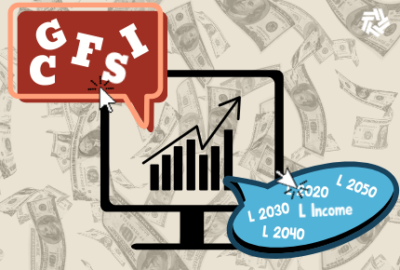
Protecting your TSP investment after retirement
When you retire, do you stick with the TSP (and its low-fees and multiple-oversight) or move into another tax-deferred investment option? That’s an important...
Investing in the federal Thrift Savings Plan while working is a no-brainer. Do it. Max your contributions (at least enough to get the government match) and go with the stock-indexed funds. Put as much as you feel comfortable in the stock indexed C, S and I funds, which (based on past performance) is where the money is. So far, so good.
But what about when you retire? Do you stick with the TSP (and its low-fees and multiple-oversight) or move into another tax-deferred investment option? That’s an important question because so many feds typically retire in December and January. And most, by a slight margin, move some or all of their TSP to an outside account. So what’s your plan?
First remember what the TSP is. And what it isn’t:
When the Federal Employees Retirement System was set up, experts said the TSP would be critical because along with Social Security and a modified civil service annuity, the TSP could supply as much as 30% to 50% of the retiree’s total income. Being in the TSP while working is a no-brainer. But what about when you retire? Or move to a job in the private sector with its own 401k plan? And investing at least enough to get the match is a no-brainer.
Do you stick with the TSP or look for a better option?
When they leave federal government more than half of feds take some or all of their money out of the Thrift Savings Plan. Many think outside IRAs offer them more investment and withdrawal options and active advice they can’t get from the TSP — which they do. The question is: Is that a good thing? Earlier this year we asked Abraham Grungold, a successful TSP investor and financial coach, about nurturing your retirement nest egg after retirement. And what about making it “safe” by putting it in the Treasury securities G-fund.
During the Great Recession of 2008-2009, hundreds of thousands of federal-postal investors took money out of their stock indexed C, S and I funds and put it into the Treasury securities G fund for stability. Many missed the record rebound of the stock market and the 11-year long bull market.
Although today’s pandemic situation is totally different — and a lot more frightening — than any recession, and is being dealt with more aggressively, nobody knows when it is going to get better, or pending vaccines notwithstanding, if the worst is yet to come. Here’s what he’s telling his clients:
Whether you are retired or whether you are leaving federal service mid-career to take a position in the private sector, there is always the decision of how to handle your Thrift Savings Plan.
The main question that faces many federal employees is whether to maintain their TSP investments with the government or transfer them to an Individual Retirement Account brokerage account. This is a question that is not easily answered. Each person has their individual lifestyle, risk level and financial pressures regarding this issue. Many employees want to cut their ties with their employer. I fully understand that. So, I feel the best way to answer this difficult situation is to address the positive and negative sides of making this decision.
No question, the TSP is the greatest 401(k) because, it provides an employer match up to 5% of employee contributions. It provides a government fund, bond fund, small capital fund, S&P 500 Index fund and an international index fund. That is five diverse investment options. It has a proven 30-year track history of successful growth, and it has the lowest administrative expense of any 401(k) plan. It also provides a loan program.
The TSP allows for monthly distributions. Recently, TSP rules have provided more flexibility for distribution options. If you choose to transfer your portfolio outside of the government, it also allows you to return your portfolio to the TSP. However, keep in mind in order to keep this available option you need to maintain a balance of $500 in order to make that return to the TSP. Closing out your TSP in retirement to a balance of zero is a final and irrevocable step. An important consideration with your TSP is when you leave federal service to seek a position in the private sector, if you have any pending loans you will have to immediately pay them off the loan. If you are less than 59 ½ years old you will have to pay the IRS 10% penalty regarding the loan.
During my federal career, when I attended our annual retirement planning conference, I would occasionally hear a presentation from a financial planner or a company that specializes in IRAs. I always heard the financial companies suggesting that moving your funds from the TSP to an individual IRA will give you more control over your assets, and you have more investment options. But be careful what you ask for. I had a client who had their 401(k) sitting with a reputable company and they were paying that custodial company a $1,500 annual administrative fee and received no services for that fee. Also, this same person was paying commissions on each mutual fund transaction.
Most important, you are exposed to investment advisers such as Bernie Madoff and many others who have deceived their client’s trust and their assets. I have a personal IRA and I receive periodic calls from someone who wants to help me manage my account. The pitch is usually expensive annuities, and junk bonds which yields them large commissions. I have never been contacted by my TSP because it is a self-directed account managed by the employee.
Personally, in retirement, I am staying with my TSP. The only thing I strongly urge is that everyone should have a designated beneficiary and make sure your loved ones know that your TSP exists. Whether you stay with the TSP or move it to an external financial custodian, it is your choice. Ask plenty of questions and do your homework, it is ultimately, your decision.
Any questions or comments please contact me on LinkedIn or Facebook.
Nearly Useless Factoid
By Alazar Moges
The Ancient Romans used to drop a piece of toast into their wine for good health – hence why we “raise a toast.”
Source: Cosmopolitan
Copyright © 2025 Federal News Network. All rights reserved. This website is not intended for users located within the European Economic Area.
Mike Causey is senior correspondent for Federal News Network and writes his daily Federal Report column on federal employees’ pay, benefits and retirement.
Follow @mcauseyWFED
Related Stories





